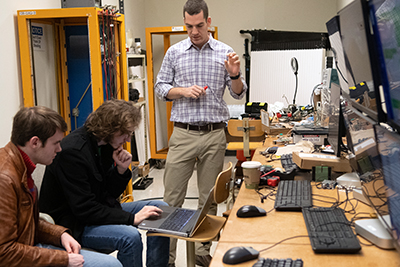 Menu
Menu

“This award marks a nice milestone for our collaboration (UD and Cerium) since we’ve now brought in over a million dollars between the two projects,” said Flanagan. “Furthermore, both of our projects have moved from ‘Phase I’ to ‘Phase II’ contracts, which demonstrates that the Air Force believes we are doing meaningful work.”
Gas turbine engines (GTEs) operate at high temperatures, submersed in a high-density gas. Thermal barrier coatings (TBCs) are widely used to protect the engine superalloys from oxidation and other degradation. These TBCs are vulnerable to calcium-magnesium-aluminum-silicate (CMAS) deposits and volcanic ash penetration. Cerium Labs is exploring a silicon nitride seal that can protect the TBC, allowing increased engine performance and decreased corrosion.
Advantages of silicon nitride seals include allowing for higher temperature operations, improving engine efficiency, decreasing thermal barrier corrosion, leading to a longer engine lifetime, and promoting a surface reaction that conforms to part geometry.
Flanagan has been the principal investigator of previous successful AFWERX STTR projects. Steinmiller is the co-principal investigator of the Keck Foundation Grant that purchased the scanning electron microscope (SEM) to be used on this project. She is an analytical chemist with a lab equipped to complement SEM measurements. UD will provide SEM images before and after CVD depositions as well as before and after corrosion/annealing tests.
UD will use part of the grant proceeds to hire a one-year postdoc position to work on this project. The postdoc will also teach a course to further their academic career and UD’s mission. Flanagan and Steinmiller are currently interviewing candidates for this position, hopeful of finding someone who is both a good fit and likely to leave a strong mark for UD STEM.
“I’m really excited about the opportunity this provides to UD,” said Flanagan. “We’ve wanted to have a materials science course such as solid state physics, but for one reason or another we haven’t found room in the schedule and the right person to teach it. Our new hire will be able to help us with this as well as do some impactful research.”
Flanagan and Steinmiller recently learned that they will be awarded an additional STTR contract, this one dealing with the “radiation hardening” of memory chips and very closely tied to last year’s neutron project. This newest contract is classified as a “Phase I,” worth $150,000 total, $45,000 for UD.
“I’ve been thrilled with the work we’ve done in my lab these past three years,” added Flanagan. “Year after year, these exceptional students exceed my expectations, whether we are talking about Aidan Medcalf’s work at CERN in the summer of 2018, Steven Block’s custom electronics for our light detectors, or John Rabaey’s electronics work at Fermilab in the summer of 2019. I could go on and on. These UD students are phenomenal. I think there is something dynamic with their well-rounded education combined with being a STEM major.”